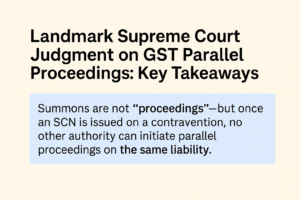The phased implementation of reporting HSN (Harmonized System of Nomenclature) codes in GSTR-1 and GSTR-1A has reached its third phase. Effective from the February 2025 return period, this initiative aims to enhance accuracy, compliance, and user convenience in reporting GST transactions.
Key Highlights of Phase III
- Mandatory Use of Dropdown for HSN Codes
In Phase III, manual entry of HSN codes is no longer permitted. Taxpayers must select the correct HSN codes from a dropdown menu. This ensures consistency and reduces the chances of errors in reporting. Along with this, the description corresponding to the selected HSN code will auto-populate a new field titled “Description as per HSN Code.” - Separate Tabs for B2B and B2C Supplies
Table 12 of GSTR-1/1A is now divided into two distinct sections:- B2B Supplies: For reporting transactions between registered taxpayers.
- B2C Supplies: For reporting transactions involving unregistered recipients.
This bifurcation allows for clearer reporting and categorization of supplies.
- Validation of Supply Values and Tax Amounts
The GST portal now introduces validations to cross-check the values of supplies and associated tax amounts in Table 12 against other relevant tables:- For B2B Supplies: Data in Table 12 is validated against values in Tables 4A, 4B, 6B, 6C, and others related to registered recipients.
- For B2C Supplies: Data in Table 12 is validated against values in Tables 5A, 6A, 7A, and others related to unregistered recipients.
These validations are currently implemented in “warning mode,” meaning mismatches will generate alerts without preventing filing. However, consistent discrepancies should be addressed promptly to avoid future compliance issues.
- Enhanced Functionalities for Ease of Use
Several new features have been introduced:- “Download HSN Codes List” Button: Taxpayers can download an updated list of HSN and SAC codes in an Excel format, complete with descriptions.
- Searchable Product Name: A searchable “Product Name as in My Master” option allows taxpayers to retrieve HSN codes and descriptions based on their predefined master data, simplifying the process.
- Clarifications on Amendments and Reporting
In cases of amendments, only the differential values will be considered for validation. Additionally, if B2B supplies are reported in other sections of GSTR-1, the corresponding B2B tab in Table 12 cannot be left empty.
Context and Objectives
The implementation of Phase III follows the earlier phases:
- Phase I (2020): Introduced mandatory reporting of 4-digit or 6-digit HSN codes based on Aggregate Annual Turnover (AATO).
- Phase II (2022): Allowed manual HSN entry with alerts for discrepancies but still permitted filing despite errors.
With Phase III, the government takes a significant step toward ensuring accuracy and reducing manual errors. By automating the selection of HSN codes and introducing validations, the system enhances the overall compliance process for taxpayers.
Initial Impact and Future Directions
During the initial rollout, the validation warnings allow taxpayers time to familiarize themselves with the changes without disrupting the filing process. However, businesses must promptly align their processes with these changes to avoid potential non-compliance in subsequent phases.
Phase IV, expected to include stricter enforcement and additional functionalities, will be communicated in due course.
This phased approach underscores the government’s commitment to streamlining GST compliance and fostering a more efficient tax ecosystem for businesses across India.
Read in details:-updated_advisory_on_hsn_validation_21.01.25.pdf



Add comment